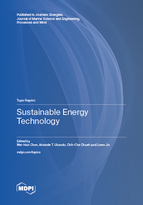Topic Menu
► Topic MenuTopic Editors




Sustainable Energy Technology

A printed edition is available here.
Topic Information
Dear Colleagues,
The Topic Sustainable Energy Technology covers technologies, products, equipment, and devices as well as energy services based on software and data protected by patents and/or trademarks. Recent trends underline the principles of a circular economy such as sustainable product design, extending the product lifecycle, reusability, and recycling. Climate change, environmental impact, and limited natural resources require scientific research and novel technical solutions. The Topic Sustainable Energy Technology is a publishing platform for scientific and technological approaches to “green”—i.e., environmentally friendly and sustainable—technologies. While a focus lies on energy and bioenergy, it also covers “green” solutions in all aspects of industrial engineering. Sustainable Energy Technology addresses researchers, advanced students, technical consultants as well as decision makers in industries and politics. This Topic will include a comprehensive overview and in-depth technical research paper addressing recent progress in sustainable energy technology. Studies of advanced techniques and methods in sustainable energy technology are also welcome. Research involving experimental and numerical studies, recent developments, and the current state-of-the-art and emerging technologies in this field are highly encouraged.
Prof. Dr. Wei-Hsin Chen
Prof. Dr. Aristotle T. Ubando
Prof. Dr. Chih-Che Chueh
Prof. Dr. Liwen Jin
Topic Editors
Keywords
- bioenergy
- solar energy
- wind energy
- marine energy
- geothermal energy
- hydrogen energy
- energy storage
- energy saving
- CO2 capture and utilization
- thermoelectric generation
- thermodynamics
- heat transfer
Participating Journals
| Journal Name | Impact Factor | CiteScore | Launched Year | First Decision (median) | APC |
|---|---|---|---|---|---|

Energies
|
3.2 | 5.5 | 2008 | 16.1 Days | CHF 2600 |

Journal of Marine Science and Engineering
|
2.9 | 3.7 | 2013 | 15.4 Days | CHF 2600 |

Processes
|
3.5 | 4.7 | 2013 | 13.7 Days | CHF 2400 |

Solar
|
- | - | 2021 | 16.9 Days | CHF 1000 |

Wind
|
- | - | 2021 | 24.8 Days | CHF 1000 |

MDPI Topics is cooperating with Preprints.org and has built a direct connection between MDPI journals and Preprints.org. Authors are encouraged to enjoy the benefits by posting a preprint at Preprints.org prior to publication:
- Immediately share your ideas ahead of publication and establish your research priority;
- Protect your idea from being stolen with this time-stamped preprint article;
- Enhance the exposure and impact of your research;
- Receive feedback from your peers in advance;
- Have it indexed in Web of Science (Preprint Citation Index), Google Scholar, Crossref, SHARE, PrePubMed, Scilit and Europe PMC.

